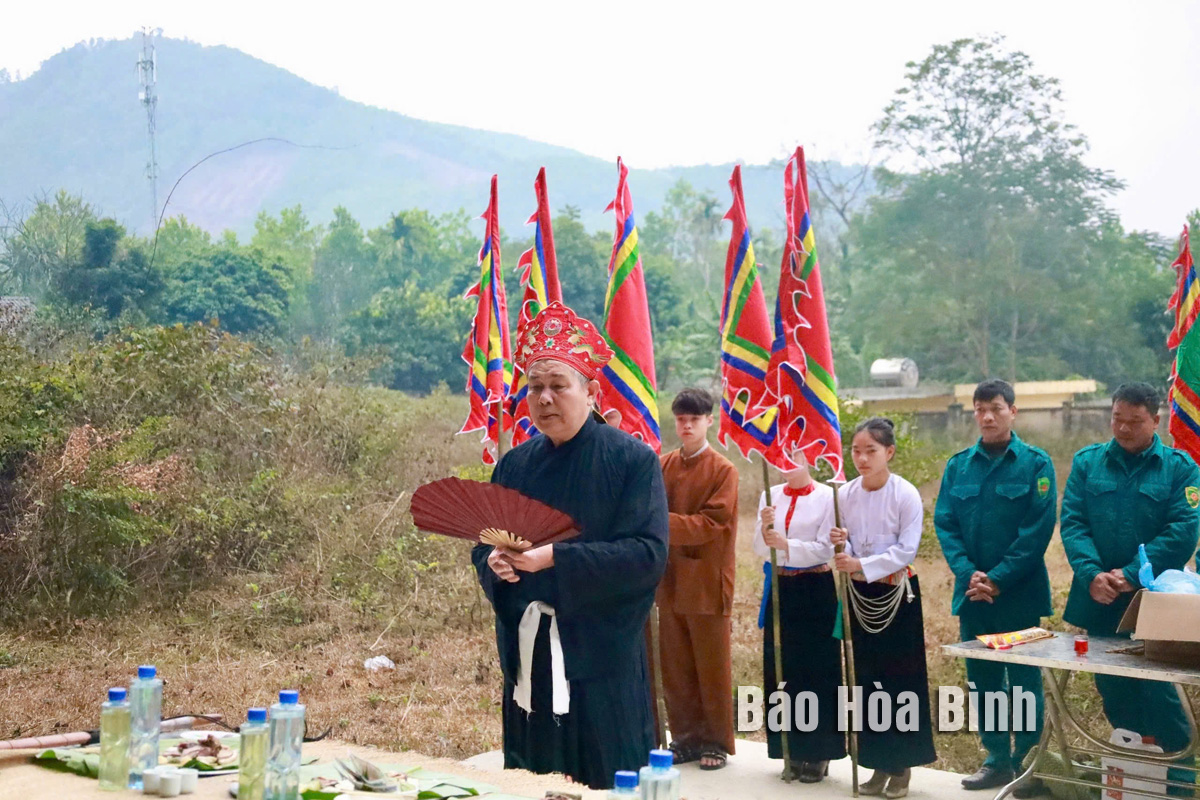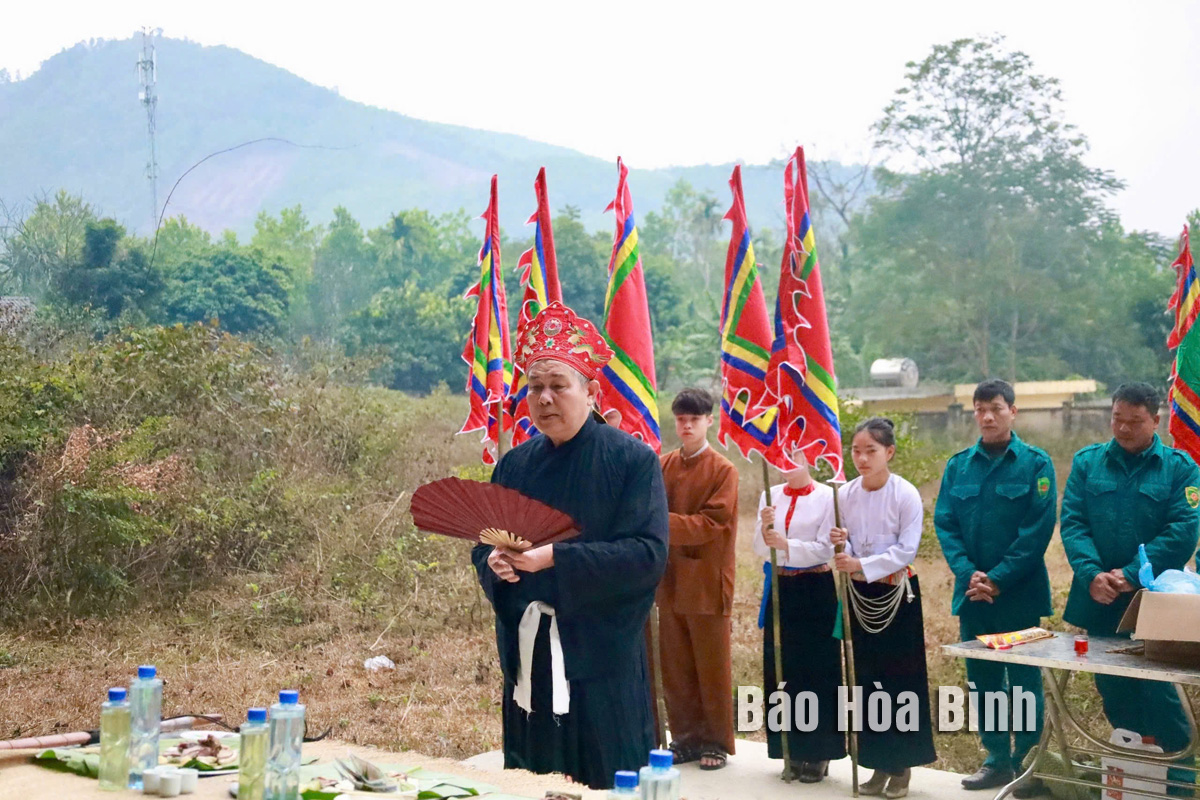
Mo is a term referring to a profession and cultural heritage which integrates folk beliefs with folk culture and arts. Practiced at funerals and religious rituals by the Muong ethnic people, it aims to provide spiritual comfort during significant life events such as illness and death.
Shaman Bui Van Sinh in Yen Phu commune, Lac Son district performs
Mo Muong rituals at Mai da lang vang (the stone roof of Vanh village).
Mo Muong is the Muong people's unique and
significant cultural heritage which leaves deep influences on many aspects of
their lives for generations. It embodies profound humanistic, cultural, and historical values, as well as the linguistic and literary traditions of the
Muong people. Mo Muong can be considered a "folk encyclopedia” on the ethnic
minority group. It consists of three main elements: wording, worship ritual,
and practitioners, with wording playing the most crucial role.
In general, Mo Muong is a collection of oral
verses that are passed down through generations. During rituals, a shaman
chants Mo verses and chapters in specific melodies that align with the content
and purpose of the ceremony.
Mo artisan is the person who performs these
sacred chants. Currently, there are approximately 200 Mo artisans in Hoa Binh
province. In Muong communities, they are highly respected and known as thay mo,
po mo, or ong au, but thay mo (shaman) is the most common title. Throughout
history, Mo practitioners have been spiritual pillars for the Muong people,
guiding them through life's uncertainties.
Mo profession refers to those who earn a living
through this practice. This job requires training, often passed down within
families. A distinctive feature of shamans' attire is their hats. In the Lac Son
district, when conducting funeral ceremonies, shamans wear hats shaped like two
forward-facing wild buffalo horns, symbolizing power and spiritual authority.
These red hats and their decorative bands are embroidered with sacred animals
such as turtles, dragons, phoenixes, birds, and fish each representing their
outlook on life. Shamans also carry khot, a fabric bag containing sacred
objects used for self-protection and warding off evil spirits during rituals.
Mo encapsulates the cultural essence of the
Muong people. Within its poetic verses, Mo preserves ancient folktales,
legends, myths, and epics. These narratives reflect history, explain natural
phenomena, and convey ancestral wisdom. Notably, Mo Muong serves as a vital
repository of the ancient Muong language. Many geographical names, plant
species, rivers, and streams mentioned in Mo Muong correspond to real places
within Muong territories, apart from mythological realms.
Moreover, Mo Muong reflects the Muong people’s
philosophy of life, their worldview and perceptions of the universe which is
believed to have three levels and five worlds, along with their production
experience, calendar, plant classification, and knowledge of interacting with
nature.
Mo Muong also embodies folk religious beliefs,
including ancestor worship, veneration of the progenitor of Mo, rituals for the
living, plant worship, and sacrifice rites, as seen in Mo buffalo, Mo cow, or
Mo chicken
Today, Mo continues to be cherished by the Muong
people. Despite adaptations in funeral practices, Mo rituals remain an
essential part of their traditions. The number of roong mo, similar to chapters
in literature, has been minimised, retaining only the most crucial ones for
ceremonial purposes. The values of Mo continue to accompany the Muong people into
the future as a foundational cultural element.
In 2015, Hoa Binh received the sponsorship of
the Vietnam Federation of UNESCO Associations for its Mo Muong. One year later,
the Minister of Culture, Sports and Tourism issued a decision adding it to the national
intangible cultural heritage list. In 2020, the Prime Minister ordered building
a dossier for Mo Muong seeking its inclusion in the UNESCO List of Intangible
Cultural Heritage in Need of Urgent Safeguarding. These developments further
highlight the enduring significance of Mo Muong as a treasured cultural
heritage.
With an increasingly vibrant and widespread emulation movement aimed at building cultured residential areas and cultured families, Yen Thuy District has been making steady progress toward improving both the material and spiritual well-being of its people, while fostering a civilized, prosperous, beautiful, and progressive community.
Once lacking recreational spaces and community facilities, Residential Group 2 in Quynh Lam Ward (Hoa Binh City) has recently received attention for the construction of a new, spacious, and fully equipped cultural house. The project followed the model of state support combined with public contributions in both labor and funding.
The "All people unite to build cultural life" movement, which has been effectively integrated with Kim Boi district’s socio-economic development goals, is fostering a lively spirit of emulation across local residential areas, hamlets, villages, public agencies, and enterprises. In addition, through the initiative, traditional cultural values are being preserved and promoted, while community solidarity and mutual support in poverty reduction and economic development are being strengthened.
A working delegation of the Hoa Binh provincial People’s Committee led by its Permanent Vice Chairman Nguyen Van Toan on June 11 inspected the progress of a project to build the Mo Muong Cultural Heritage Conservation Space linked to tourism services in Hop Phong commune, Cao Phong district.
Born and growing in the heroic land of Muong Dong, Dinh Thi Kieu Dung, a resident in Bo town of Kim Boi district, in her childhood was nurtured by the sweet lullabies of her grandmother and mother. These melodies deeply imprinted on her soul, becoming an inseparable part of her love for her ethnic group's culture. For over 20 years, this love for her hometown has driven Dung to research, collect, and pass down the cultural values of the Muong people to future generations.
In the final days of May, the Ethnic Art Troupe of Hoa Binh Province organized performances to serve the people in remote, mountainous, and particularly disadvantaged areas within the province. These were not just ordinary artistic shows, but they were the meaningful journeys aimed at spreading cultural values, enhancing the spiritual life of the people and contributing to the preservation of ethnic minority cultural identities.



